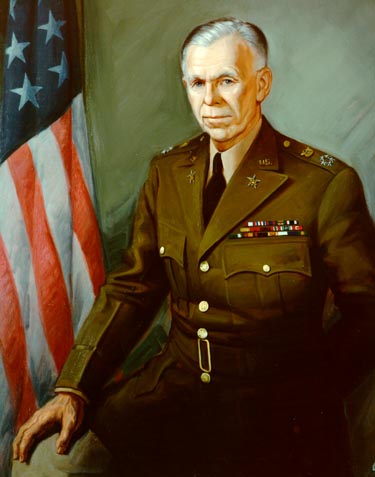By John Edward Bannon
Oil on canvas, 40
George Catlett Marshall was born in Uniontown, Pennsylvania, on 31 December 1880; graduated from Virginia Military Institute, 1901; married Elizabeth Carter Cole, 1902 (deceased 1927); was commissioned a second lieutenant, February 1902, and served with the 30th Infantry in the Philippines, 19021903, and at Fort Reno, 19031906; was promoted to first lieutenant, March 1907; at Fort Leavenworth, graduated from the Infantry and Cavalry School (1907) and was a student (1908) and instructor (19081910) at the Staff College; was inspector-instructor of the Massachusetts National Guard, 19111912, then served with the 4th Infantry at Forts Logan H. Roots and Crocket, and the 13th Infantry in the Philippines, 19131916; was promoted to captain, July 1917, and then to temporary major, August 1917, lieutenant colonel, January 1918, and colonel, August 1918; served with the American Expeditionary Forces in France as operations officer of the 1st Division and the First Army, and chief of staff of the VIII Corps, 19171918, participating in the Cantigny, Aisne-Marne, St. Mihiel, and Meuse-Argonne operations; was aide to General John J. Pershing, 19191924; was promoted to permanent major, July 1920, and lieutenant colonel, August 1923; commanded the 15th Infantry in China, 19241927; was instructor at the Army War College, 1927, and assistant commandant of the Infantry School at Fort Benning, 19271932; married Katherine Boyce Tupper Brown, 1930; was promoted to colonel and placed in command of the 8th Infantry at Fort Screven, September 1933; was senior instructor of the Illinois National Guard, 19331936; was promoted to brigadier general, October 1936, and was commander of the 5th Infantry Brigade, 19361938; was head of the War Plans Division, General Staff, 1938; was deputy chief of staff, 19381939, and acting chief, JulySeptember 1939; was promoted to major general and immediately full general, September 1939; was chief of staff of the United States Army, 1 September 193918 November 1945; centralized the professional leadership of the Army in the chief of staffs office; exercised control over mobilization, staff planning, industrial conversion, and personnel requirements; streamlined administration and tactical organization; mastered grand strategy and was the principal American military architect of Allied victory; was promoted to temporary grade of General of the Army, December 1944 (made permanent retroactively in April 1946); was special representative of the president to China, 19451947; retired from active service, February 1947; was secretary of state, 21 January 194721 January 1949; was the architect of the Marshall Plan to aid European nations, April 1948; was restored to the active list, March 1949; was president of the American Red Cross, 19491950; was secretary of defense, 12 September 195012 September 1951; received the Nobel Peace Prize for the Marshall Plan, 1953; was chairman of the American Battle Monuments Commission, 19491959; died in Washington, D.C., on 16 October 1959.
The Artist
John Edward Bannon (1933) was born in Baltimore, Maryland. He received a bachelor of fine arts degree from the Maryland Institute of Art and a master of fine arts degree from the University of Pennsylvania. Initially as a student and later as an associate, he studied with M. Jacques Maroger, former technical director of the laboratories of The Louvre and president of the Society of Restorers of France. Mr. Bannon teaches art at the Northern Virginia Community College in Annandale, Virginia, and maintains a studio in the Torpedo Factory Art Center in Alexandria, Virginia. He works in a variety of media including oil, pastel, pen, sculpture, and lithography. He has painted the portraits of Pope John XXIII and Senator Charles M. Mathias.
George Catlett Marshall
By John Edward Bannon
Oil on canvas, 40![]() "
x 36", 1974
"
x 36", 1974
[120]
